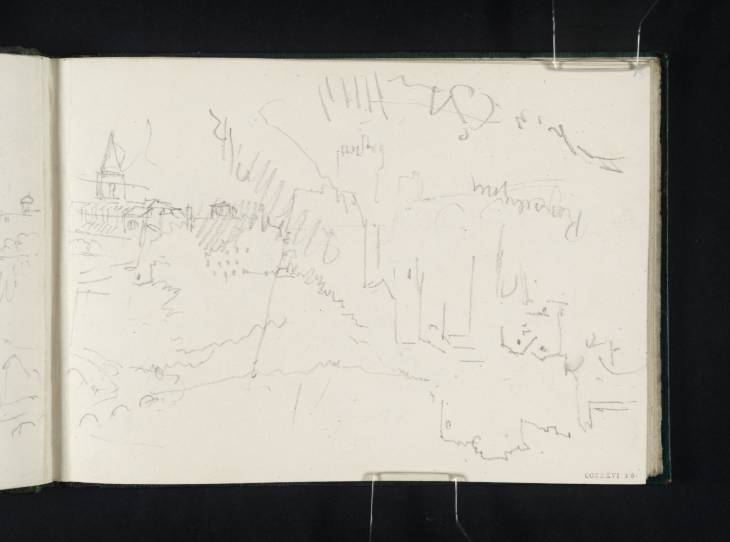Joseph Mallord William Turner Nepi, with the Cathedral of Santa Maria Assunta; Ronciglione, with the Porta Romana 1828
Image 1 of 2
Joseph Mallord William Turner,
Nepi, with the Cathedral of Santa Maria Assunta; Ronciglione, with the Porta Romana
1828
Folio 13 Recto:
Nepi, with the Cathedral of Santa Maria Assunta; Ronciglione, with the Porta Romana 1828
D21789
Turner Bequest CCXXXVI 13
Turner Bequest CCXXXVI 13
Pencil on white wove paper, 125 x 171 mm
Inscribed in pencil by Turner ‘Ronciglione’ towards top right, upside down
Inscribed in blue ink by John Ruskin ‘13’ top right and ‘173’ bottom right
Stamped in black ‘CCXXXVI 13’ bottom right
Inscribed in pencil by Turner ‘Ronciglione’ towards top right, upside down
Inscribed in blue ink by John Ruskin ‘13’ top right and ‘173’ bottom right
Stamped in black ‘CCXXXVI 13’ bottom right
Accepted by the nation as part of the Turner Bequest 1856
References
1909
A.J. Finberg, A Complete Inventory of the Drawings of the Turner Bequest, London 1909, vol.II, p.723, CCXXXVI 13, as ‘“Ronciglione.”’.
1984
Cecilia Powell, ‘Turner on Classic Ground: His Visits to Central and Southern Italy and Related Paintings and Drawings’, unpublished Ph.D thesis, Courtauld Institute of Art, University of London 1984, p.436.
The left half of this page features part of a panorama of Nepi in the Viterbo province, which begins on folio 12 verso (D21788) opposite, and includes the Palazzo Comunale and Church of San Pietro, among other monuments. The principal landmark depicted here is the Cathedral of Santa Maria Assunta, which stands on the site of an ancient Roman forum.1 The belltower once had a spire, as shown here by Turner, a feature that no longer exists. Reconstructive works were carried out on the cathedral between 1818 and 1840, which the artist may well have witnessed.
In the foreground below is a stretch of the aqueduct, designed in the ancient Roman style and constructed between the sixteenth and early eighteenth centuries.2 Turner’s vantage point for this panoramic view of Nepi was likely from the north-west. This is one of twenty-one works depicting Nepi in the present sketchbook; for further commentary on Turner’s second visit to the town in 1828, together with a list of relevant works, see under folio 12 verso (D21788). For a similar composition from Turner’s first major tour of Italy in 1819–20, see the double-page panorama in the Ancona to Rome sketchbook (Tate D14814–D14815; Turner Bequest CLXXVII 82a–83).
To the right of the page, inverted relative to the view of Nepi, is a rough sketch of the neighbouring town of Ronciglione, located further to the west. Turner’s upside-down inscription confirms this location. In view is the eastern slope of the town and the early seventeenth-century Porta Romana, the main gateway from the south. See under folio 8 recto (D21779) for a more extensive commentary on this location and a list of relevant works in the sketchbook.
Hannah Kaspar
December 2024
‘The Cathedral’, Museo Civico Nepi, accessed 31 July 2024, https://www.museociviconepi.it/en/monuments/cathedral/ .
‘The Aqueduct’, Museo Civico Nepi, accessed 31 July 2024, https://www.museociviconepi.it/en/monuments/the-aqueduct/ .
How to cite
Hannah Kaspar, ‘Nepi, with the Cathedral of Santa Maria Assunta; Ronciglione, with the Porta Romana 1828’, catalogue entry, December 2024, in David Blayney Brown (ed.), J.M.W. Turner: Sketchbooks, Drawings and Watercolours, Tate Research Publication, February 2025, https://www


